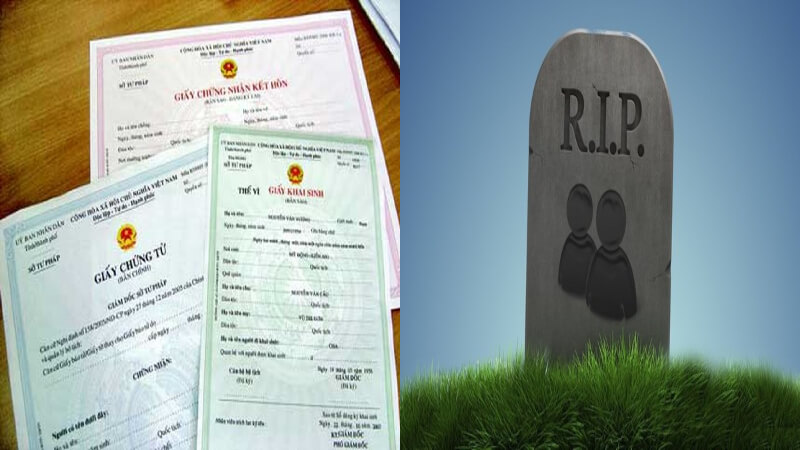If you’re looking to learn about death registration procedures, this article is for you!
1 What is a Death Certificate?

A death certificate, also known as a death record, is an official vital record issued by a government authority to confirm an individual’s death and the cessation of their legal rights from the time of death. It is typically issued to the spouse, parent, child, or other close relative of the deceased.
The death certificate serves as a crucial document for various legal purposes, including:
-
Determining the time of inheritance
-
Settling death benefits
-
Establishing marital status for remarriage
-
Identifying joint marital property
-
Dividing inheritance
-
Claiming insurance benefits and other entitlements
2 Death Registration Procedures
Procedures for Registering the Death of a Vietnamese Citizen
 Death Registration Procedures for Vietnamese Citizens
Death Registration Procedures for Vietnamese Citizens
Step 1: Prepare the Necessary Documents
The following documents are required for death registration:
Death Registration Application Form;
Death Certificate or an alternative document issued by an authorized agency.
Alternative documents to the Death Certificate include:
-
For deaths occurring in a medical facility: The head of the medical facility issues the Death Certificate;
-
For deaths by execution of a death sentence: The Chairman of the Death Penalty Execution Council issues a confirmation letter in place of the Death Certificate;
-
For individuals declared dead by a court: The effective court decision or judgment serves as a substitute for the Death Certificate;
-
For deaths occurring in a vehicle, accidental deaths, homicides, sudden deaths, or suspicious deaths: A confirmation letter from the police or a forensic examination report from the Forensic Examination Agency can be used instead of the Death Certificate.
Authorization letter if someone else is appointed to carry out the death registration.
The authorization letter does not require notarization or authentication if the authorized person is a grandparent, parent, child, spouse, sibling, or other close relative of the registrant. However, proof of the relationship with the registrant is necessary, such as:
-
A valid passport, ID card, or other recognized photo identification documents issued by competent authorities to confirm the identity of the person requesting death registration.
-
Documents proving the last residence of the deceased to determine the competent authority for death registration.
-
In cases where the last residence cannot be determined, proof of the place of death or where the body was found should be provided.
-
If submitting the documents by postal services, certified true copies of the above documents must be included.
Note: Other close relatives mentioned above refer to those listed in Article 3, Clause 19 of the Law on Marriage and Family 2014, which includes individuals with marital, adoptive, lineal blood, and collateral blood relationships within three degrees of kinship.
Step 2: Submit the Documents
The receiving officer will check and verify the information in the application form and the validity of the submitted documents:
-
If the documents are valid and complete, the receiving officer will issue a receipt stating the date and time for receiving the results. If the documents are incomplete, the applicant will be guided on how to complete the application.
-
If the applicant fails to complete the application as instructed, the receiving officer will refuse to accept the application and issue a written notice of refusal, stating the reason for the refusal and the name of the receiving officer.
-
If the applicant cannot immediately complete or supplement the application, the receiving officer must provide a written guide detailing the required documents and information. This notice should be signed and stamped with the name and position of the receiving officer.
Note: There are three ways to submit the application: in person, online, or by postal services. Applicants can choose the method that best suits their convenience and circumstances.
Step 3: Process the Death Registration
The civil status official is responsible for recording the death in the Civil Status Register and signing the register along with the applicant. The Chairman of the commune-level People’s Committee will then issue an extract from the register to the applicant.
The civil status official will also lock the deceased’s information in the National Civil Status Database.
Procedures for Registering the Death of a Foreign National or Overseas Vietnamese Citizen in Vietnam
 Death Registration for Non-Vietnamese Citizens
Death Registration for Non-Vietnamese Citizens
Step 1: Prepare the Necessary Documents
The required documents for death registration of a foreign national or overseas Vietnamese citizen are the same as those for a Vietnamese citizen.
Step 2: Submit the Documents
The receiving officer will check the application and the validity of the submitted documents provided by the applicant.
-
If the documents are valid and complete, the receiving officer will issue a receipt stating the date and time for receiving the results. If the documents are incomplete or require improvement, the applicant will be guided on how to complete or improve the application.
-
If the applicant fails to complete or improve the application as instructed, the receiving officer will refuse to accept the application and issue a written notice of refusal, stating the reason for the refusal and the name of the receiving officer.
-
If the applicant cannot immediately complete or improve the application, the receiving officer must provide a written guide detailing the required documents and improvements. This notice should be signed and stamped with the name and position of the receiving officer.
Step 3: Process the Death Registration
The civil status official will record the death in the Civil Status Register and sign the register along with the applicant. The Chairman of the district-level People’s Committee will then issue an extract from the register to the applicant.
Step 4: Notify the Ministry of Foreign Affairs
The district-level People’s Committee will notify the Ministry of Foreign Affairs in writing, attaching the extract from the Civil Status Register. This notification is to inform the competent authority of the deceased’s country of their citizen’s death.
If the deceased is an overseas Vietnamese citizen, the civil status official will lock the deceased’s information in the National Civil Status Database.
3 Time Limit and Responsibility for Death Registration
 Time Limit for Death Registration
Time Limit for Death Registration
For Vietnamese Citizens
Within 15 days from the time of death, the spouse, child, parent, or other close relative of the deceased must submit the necessary documents for death registration to the commune-level People’s Committee where the deceased last resided.
If the deceased has no close relatives, a representative from a relevant organization or individual is responsible for carrying out the death registration.
For Foreign Nationals or Overseas Vietnamese Citizens Dying in Vietnam
Within 15 days from the time of death, the spouse, child, parent, or other close relative of the deceased must submit the necessary documents for death registration to the district-level People’s Committee where the deceased last resided.
4 Death Registration Fees
 Not Everyone is Exempt from Fees
Not Everyone is Exempt from Fees
-
In cases of timely death registration, individuals from families with revolutionary contributions, low-income households, or disabled people are exempt from registration fees.
-
For late registration exceeding the 15-day time limit, registration fees must be paid as determined by the Provincial People’s Council in the respective locality.
We hope that through this detailed guide on death registration procedures, you now have a better understanding of the process. If you have any further questions, please don’t hesitate to reach out to the relevant authorities for assistance.

































